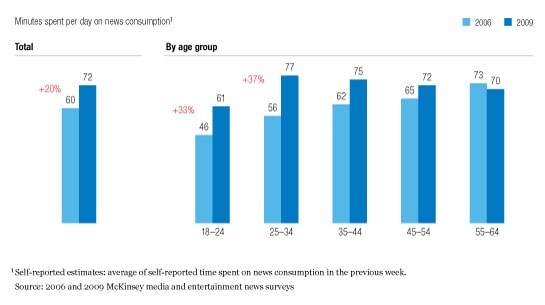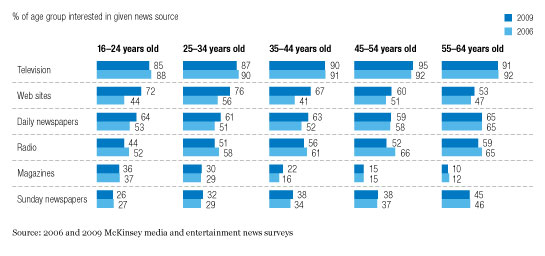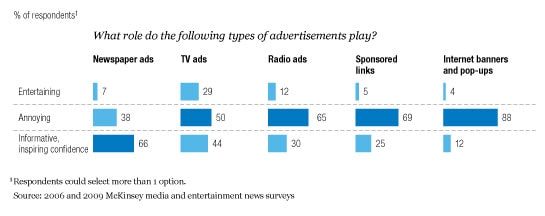News consumption in the United Kingdom rose by 20 percent in the past three years, according to new McKinsey research.1 Average consumption has risen to 72 minutes a day, compared with 60 minutes in 2006—an increase driven almost entirely by people under the age of 35 (Exhibit 1). Two-fifths of those in this age group said they felt the need to be the first to hear the news, compared with just 10 percent of people aged 55 to 64.
This need for immediacy is reflected in younger news consumers’ choice of media: they overwhelmingly prefer to get their news from television and the Internet (Exhibit 2). While television remains the most popular medium across all age groups, only the behavior of consumers 55 and older prevented the Internet from jumping from fourth in 2006 to become the second most popular news source today. Instead, the Internet is now in third place, just behind newspapers.
More news, younger fans

News on the Web

These findings underline the challenges that lie ahead for newspapers, in the United Kingdom and elsewhere, that are struggling to address long-term circulation and advertising declines caused mainly by the growth of online news consumption and Internet advertising. Some newspapers are eyeing differentiated and innovative revenue models for their online content. But these won’t be a silver bullet: we found that while there is modest potential to increase online revenues, they will be insufficient to compensate for the decline of print. Indeed, even in a hypothetical scenario where online-only versions of existing newspapers and magazines cost 75 percent less than the print versions, only 14 percent of news consumers said they would pay for the online content.
One finding does suggest a potential revenue opportunity: newspapers have an important inherent advantage as they face the challenges of the digital age—trust. Consumers trust newspapers more than any other medium, and 66 percent describe newspaper advertising as “informative and confidence inspiring,” compared with only 44 percent for TV and 12 percent for the Web (Exhibit 3). This suggests that newspapers have further scope to go beyond news, to drive reader interest and advertising revenues at the same time. Leading newspapers have already created specialized pages and sections in areas such as entertainment, eating out, travel, automobiles, shopping, real estate, and personal finance. The combination of editorial content, ads, and selected commercial offers—while clearly separated—benefits advertisers and is of practical use to readers.
A trusted source for news

A few publications are going one step further, moving from just selling ad space to taking a role in transactions between advertisers and consumers in these and other areas. Opportunities present themselves for publishers to drive up revenues for their print as well as online versions by becoming trusted intermediaries. They can, for example, use their call centers to administer bookings for advertised offers to test-drive new car models, partner with travel agencies to offer subscribers exclusive tours, or combine editorial news and advice on, say, gardening with opportunities to buy garden products directly from their business partners.
To survive in the digital age, newspapers will need to develop deeper skills—for example, in managing advertiser relationships and gaining customer insights—and they must walk a fine line to retain editorial independence and quality to capture these opportunities. But for those who get it right, the rewards could be significant.